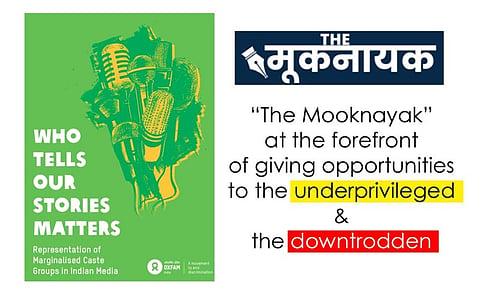
Especially people from backward and disadvantaged groups are the ones working 100% of the content for its publishing and coverage.
New Delhi— The survey report of Oxfam, a humanitarian organization and Newslaundry Media Institute on the representation of tribals, Dalits, and OBCs in the media has disclosed that "The Mooknayak" media gives opportunities to journalists and writers from the underprivileged sections of India.
This report titled "Who Tells Our Stories Matters: Representation of Marginalized Caste Groups in Indian Newsrooms" suggests that many newsrooms in the Indian media are not diverse in the context of representation. Most people working in media spaces are from the upper caste and have their own concerns. In the study, Oxfam-Newslaundry has found that the representation of people belonging to Scheduled Castes and Scheduled Tribe, especially in Indian media is extremely low in number.
However, compared to the previous year's reports, there has been an improvement in the representation of people working in the media space. The question is if the number is satisfactory. How would we define a decent number in the context of representation?
A peek into representation in The Mooknayak
According to the survey report, The Mooknayak's newsroom has the highest diversity in digital media. 54 percent of the journalists in the newsroom are from Dalit and backward societies.
The Mooknayak as a platform also has a representation of 45% from the general category out of which most of them are women journalists. Keeping in concern the marginalization of caste, class, and gender, there is an extra effort being put in by the media space as an inclusive initiative towards offering platform and representation.
Eastmojo media platform has been very close to Mooknayak in the survey. Firstpost, News Laundry, Scroll In, The Quint, The Wire, and The News Minute are included in the survey.
Dalit writers are being given maximum opportunities in The Mooknayak
According to the report, The Mooknayak has published a maximum number of articles by Dalit writers in its editorial column. East Mojo Media Group is ranked number two on the list. The Wire, The Quint, Swaraj, and Scroll In have also given opportunities to Dalit writers.
No questions were raised on Savarna occupied media positions
According to the survey, it is found that most of the crucial positions in newspapers, TV channels, magazines, and websites are occupied by the Savarna people.
The study found that out of a total of 218 crucial positions, 191 are occupied by upper-caste journalists, while there is not a single member of Scheduled Castes and Scheduled Tribes. Rajya Sabha TV, Aaj Tak, News 18, India TV, NDTV India, Republic Bharat, and Zee News all have upper-caste people holding crucial positions.
Survey reports have surfaced about the share of the oppressed class in media houses. For example, in 2006, Anil Chamadia of Media Studies Group, Delhi, and Yogendra Yadav of CSDS studied 37 media institutions.
He found that out of 315 key positions in the media at the decision-making stage, only one percent of people belonged to the Other Backward Classes.
However, the share of OBCs in key positions was 4 percent. In contrast, 71 percent of the upper castes were holding decision-making positions.
Hence, most of the concerns and issues faced by marginalized people don't reach the general population. Although in the last few years there is an increase in the number of representations in different houses, there is a huge gap that can be clearly seen in terms of the social arrangement of caste, class, and gender-based representation both within and outside the media houses.
You can also join our WhatsApp group to get premium and selected news of The Mooknayak on WhatsApp. Click here to join the WhatsApp group.